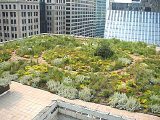Green roofs are designed to support the growth of plants. They consist of a special waterproof and root repellant membrane, a drainage system, filter cloth, a lightweight growing medium and plants installed on top of human-built buildings.

Research into the advantages of planted roofs is being carried out in universities around the world, like Sussex university in the UK, and Penn State university in the US.
Not only will it look nicer, but also a green roof will provide good sound and heat insulation, hence savings on energy for heating and cooling. It will also dramatically increase the roof lifespan and decrease the need for maintenance. Green
roofs can be used to grow herbs and vegetables, like the one on top of the Fairmount Waterfront Hotel in Vancouver, which apparently saves its kitchen an estimated $30,000 a year in food costs. Planted roofs are also a way to increase the vegetation in cities, which improves air quality and regulates temperature.
There are a number of high-profile green roof projects in the UK. The Eden project in Cornwall, the Laban Dance centre in London and more recently the London Zoo have been fitted with planted roofs. Ecover’s ecological factory is another example.
Ok, but what happens to the roof in the winter one might wonder, and isn’t all this vegetation on top of my head going to make my hay fever go haywire? No problem, say the experts, just plant non-flowering evergreens, or just grass.
Green roof plants consultancy and providers
Not for profit green roof organisation in the UKaiming to promote green roofs to developers, local government and national.